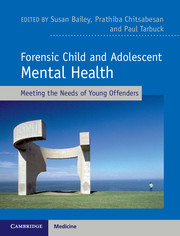Book contents
- Forensic Child and Adolescent Mental Health
- Forensic Child and Adolescent Mental Health
- Copyright page
- Dedication
- Contents
- Contributors
- Foreword
- Preface
- Prologue
- Section 1 Developmental Pathways
- Section 2 Assessment and Needs of Young Offenders
- Section 3 Serious Offences: Origins, Nature and Treatment
- Section 4 Assessment and Management
- Section 5 Therapeutic Approaches
- Section 6 Legal Frameworks, Organisations and Systems
- Chapter 21 Children and the Law
- Chapter 22 Youth Justice Services in England and Wales
- Chapter 23 Working with Young People in a Secure Environment
- Epilogue
- Index
- References
Chapter 21 - Children and the Law
from Section 6 - Legal Frameworks, Organisations and Systems
Published online by Cambridge University Press: 04 May 2017
- Forensic Child and Adolescent Mental Health
- Forensic Child and Adolescent Mental Health
- Copyright page
- Dedication
- Contents
- Contributors
- Foreword
- Preface
- Prologue
- Section 1 Developmental Pathways
- Section 2 Assessment and Needs of Young Offenders
- Section 3 Serious Offences: Origins, Nature and Treatment
- Section 4 Assessment and Management
- Section 5 Therapeutic Approaches
- Section 6 Legal Frameworks, Organisations and Systems
- Chapter 21 Children and the Law
- Chapter 22 Youth Justice Services in England and Wales
- Chapter 23 Working with Young People in a Secure Environment
- Epilogue
- Index
- References
- Type
- Chapter
- Information
- Forensic Child and Adolescent Mental HealthMeeting the Needs of Young Offenders, pp. 289 - 299Publisher: Cambridge University PressPrint publication year: 2017

